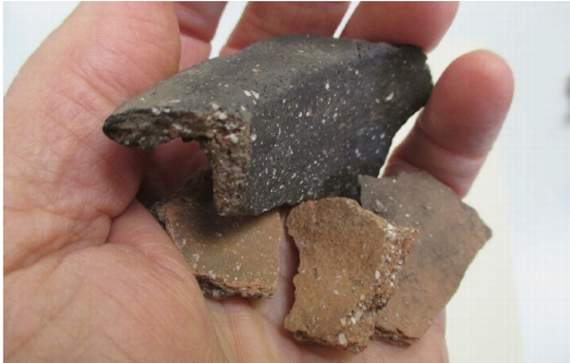MONMOUTH archaeologists, helped by Mike Emery Builders and senior officers of Monmouthshire County Council (MCC), have discovered new evidence of a Saxon settlement in the town during rescue excavations inside Commerce House at Monmouth bus station.
The settlement is believed to be the only Anglo-Saxon settlement in South Wales.
Sherds of cooking pottery which were made in Saxon Gloucester, were found by Monmouth Archaeological Society while exploring a series of earth floors of medieval houses under the building. Pottery and bones dating from the 11th century up to the time of the Black Death in AD 1348 were recovered along with some Roman and prehistoric finds.
The suggestion that there had been an Anglo-Saxon presence in the town – possibly a defended ‘Burh’ – has always been somewhat controversial although there have been clues that there may have been one.
During an excavation which followed the illegal demolition of 85 Monnow Street an unstratified rim sherd of a ‘Chester Ware’ pot was found; this, although pre-Norman, may have arrived with the early Norman invaders after the Battle of Hastings. More recently, however, a small sherd of the Cotswold Ware made in Gloucester was identified by the society following trial excavations by the Glamorgan-Gwent Archaeological Trust on the site of the Almshouses off St James’ Square.
Now the Commerce House discovery at 95 Monnow Street appears to have settled the argument – the Saxons had, after 400 years, fought their way into Monmouth. However, patriotic Welshmen can take heart from the fact that the Saxons took 200 years to fight their way to the Severn and another 200 years to get to the Wye when they were overtaken by the Normans following the defeat of the English at Hastings; 200 years later the Welsh were still fighting these latest invaders and even rose again another 200 years later under Owain Glyndwr.
Intriguingly, there appears to have been some cooperation between the Anglo-Saxons of Hereford and Gloucester and the Welsh of the Celtic Kingdom of Archenfield where, strangely, Offa’s Dyke was never built. Monmouth was at the very tip of Archenfield, between the Monnow and the Wye and as Keith Kissack said: “Like a dagger pointed at Gwent”.
The excavators are grateful for the help and support given by Mike and Lewis Emery and MCC’s chief executive, Paul Matthews and chief planning officer, Mark Hand.
The excavators and the pottery specialist were unfunded volunteer members of Monmouth Archaeological Society who spent two weeks working in the building.

Comments
This article has no comments yet. Be the first to leave a comment.